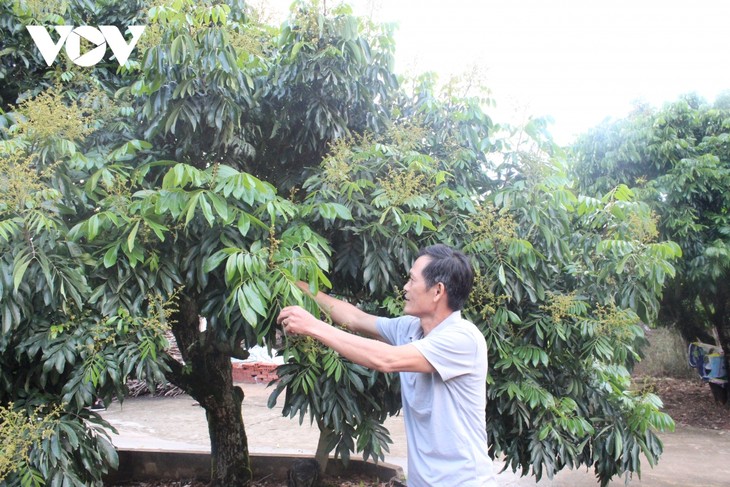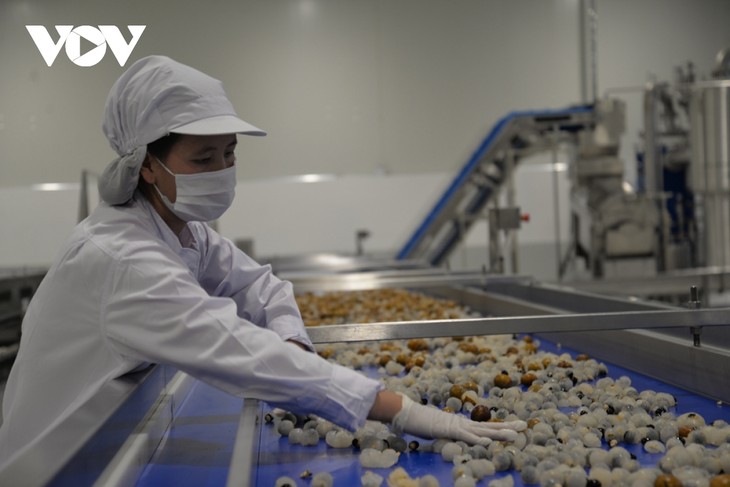(VOVWORLD) - Son La province is the largest fruit growing region in the North and has the second largest fruit cultivation land in Vietnam. Many products, including longan, plum, red-flesh dragon fruit, mango, and passion fruit, are favored by domestic consumers and exported to many major markets like China, Australia, the US, and New Zealand. Applying science and technology to production is one of the levers to develop Son La agriculture.
 Nguyen Van La in Song Ma district has switched most of his family's longan-growing land into early-ripening longan tree model. Nguyen Van La in Song Ma district has switched most of his family's longan-growing land into early-ripening longan tree model. |
Nguyen Van La’s family in Hưng Mai hamlet in Song Ma district has 1.6 hectares of longan. His family used to grow fruit trees in the traditional way by doing intensive farming of old varieties, without creating a canopy and using the right farming techniques. As a result, after decades of growing longan, his income hadn’t improved.
Between 2017 and 2018, after learning from members of longan-growing cooperatives in the district and from local agricultural engineers how to use hybrid techniques to grow early-ripening longan trees, La family saw their income significantly increase.
“In 2019, the area of early ripening longan, known as the T6 variety, began to be harvested. My family picked more than five tons, and sold them at 1.3 USD per kilo, three or four times higher than traditional longans during the main season,” said La.
Like La's family, Lo Van Thuong of Muong Bu hamlet in Muong La district grew apples, jackfruit, and mango on 1.4 hectares, but he used old varieties, and planted and cared for them in the traditional way. The output was very low.
Now, thanks to advance methods of tilling the soil, applying fertilizer and insecticide, and wrapping the fruit, he has expanded his fruit growing area to 12 hectares and has planted more productive, higher-quality varieties. The price of his hybrid apples is two to three times higher than the old variety, and his custard apples and durians sell for more than 21 USD per kilo. This has boosted his family's income by several thousands of dollars per year.
Thuong recalled, “In the past, my family only planted the native low-quality, low-priced apple variety. Then we were taught technical farming and we planted new varieties of apples. The harvested fruit fetches high prices, so our income is more stable now.”
 Many households in Son La have escaped poverty thanks to planting fruit trees for exports. Many households in Son La have escaped poverty thanks to planting fruit trees for exports. |
La and Thuong are just two of thousands of fruit growers who have received technical support from Son La province.
Nguyen Duy Hoang, Deputy Director of the provincial Department of Science and Technology, says that over the years Son La has pushed a program to convert fruit trees on sloping land. Research and technology transfers have been carried out in rural areas, creating a breakthrough in Son La’s fruit tree production.
Son La has 24 agricultural products, including 11 fruit trees that have been registered by the National Office of Intellectual Property in geographical indications, certification marks, and collective marks.
Many fruit products have entered the chain of safe agricultural consumer products, in line with domestic and international standards. Yen Chau round mango is on the investment protection list of the EU-Vietnam Free Trade Agreement.
 Son La province has attached importance to applying science and technology to agricultural production. Son La province has attached importance to applying science and technology to agricultural production. |
The protection certification of Son La products has boosted domestic sales and exports, said Hoang, adding the locality continues to select fruit varieties that are highly adaptable, resistant to climate change, and have better quality and higher yields.
“We’re stepping up studies of the processing and preservation of Son La fruit products. These will be the key tasks from now to 2025,” said Hoang.
To promote local strengths and agricultural restructuring until 2025, Son La will maximize the advantages of natural conditions, develop high-tech agricultural zones that meet international food safety and hygiene standards, and boost the incomes of agricultural producers. This will turn Son La province into the high-tech agricultural center of Vietnam’s northwestern region.